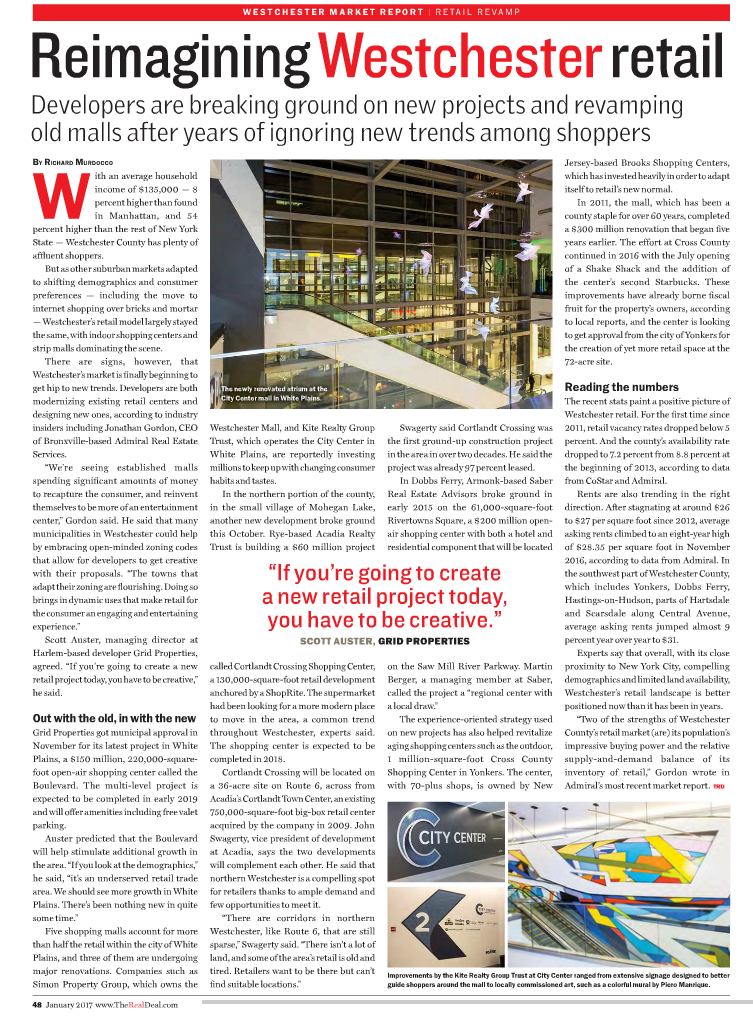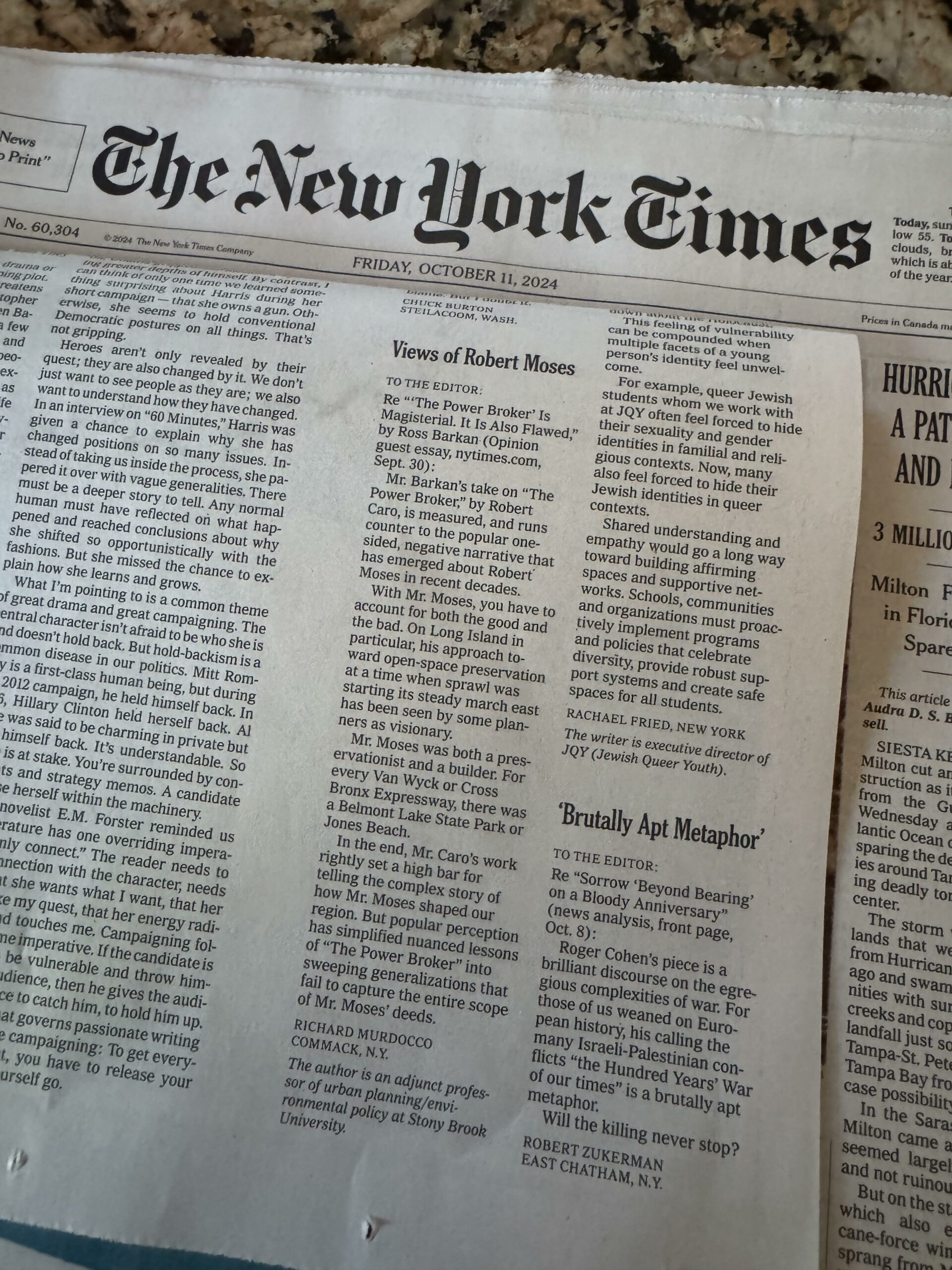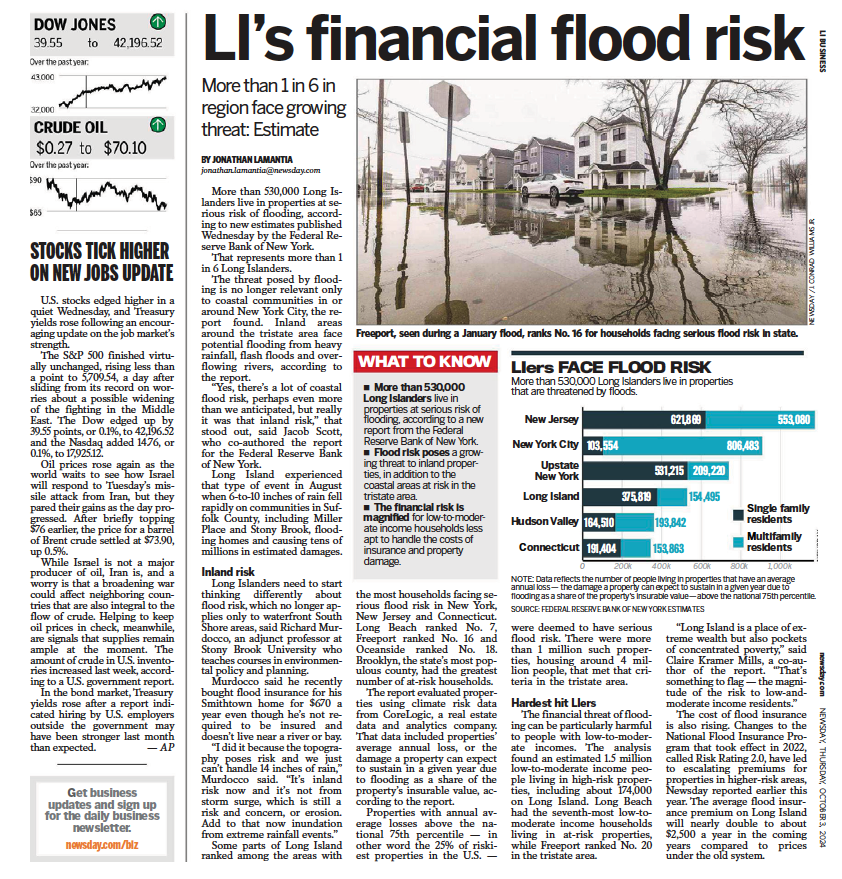The following story was written for the Real Deal’s special Westchester/Fairfield County edition in January 2017. You can read the original version here.
January 04, 2017
By Richard Murdocco

Improvements by the Kite Realty Group Trust at City Center ranged from extensive signage designed to better guide shoppers around the mall to locally commissioned art, such as a colorful mural by Piero Manrique.
With an average household income of $135,000 — 8 percent higher than found in Manhattan, and 54 percent higher than the rest of New York State — Westchester County has plenty of affluent shoppers.
But as other suburban markets adapted to shifting demographics and consumer preferences — including the move to internet shopping over bricks and mortar — Westchester’s retail model largely stayed the same, with indoor shopping centers and strip malls dominating the scene.
There are signs, however, that Westchester’s market is finally beginning to get hip to new trends. Developers are both modernizing existing retail centers and designing new ones, according to industry insiders including Jonathan Gordon, CEO of Bronxville-based Admiral Real Estate Services.
“We’re seeing established malls spending significant amounts of money to recapture the consumer, and reinvent themselves to be more of an entertainment center,” Gordon said. He said that many municipalities in Westchester could help by embracing open-minded zoning codes that allow for developers to get creative with their proposals. “The towns that adapt their zoning are flourishing. Doing so brings in dynamic uses that make retail for the consumer an engaging and entertaining experience.”
Scott Auster, managing director at Harlem-based developer Grid Properties, agreed. “If you’re going to create a new retail project today, you have to be creative,” he said.
Out with the old, in with the new
Grid Properties got municipal approval in November for its latest project in White Plains, a $150 million, 220,000-square-foot open-air shopping center called the Boulevard. The multi-level project is expected to be completed in early 2019 and will offer amenities including free valet parking.

Auster predicted that the Boulevard will help stimulate additional growth in the area. “If you look at the demographics,” he said, “it’s an underserved retail trade area. We should see more growth in White Plains. There’s been nothing new in quite some time.”
Five shopping malls account for more than half the retail within the city of White Plains, and three of them are undergoing major renovations. Companies such as Simon Property Group, which owns the Westchester Mall, and Kite Realty Group Trust, which operates the City Center in White Plains, are reportedly investing millions to keep up with changing consumer habits and tastes.
In the northern portion of the county, in the small village of Mohegan Lake, another new development broke ground this October. Rye-based Acadia Realty Trust is building a $60 million project called Cortlandt Crossing Shopping Center, a 130,000-square-foot retail development anchored by a ShopRite. The supermarket had been looking for a more modern place to move in the area, a common trend throughout Westchester, experts said. The shopping center is expected to be completed in 2018.
Cortlandt Crossing will be located on a 36-acre site on Route 6, across from Acadia’s Cortlandt Town Center, an existing 750,000-square-foot big-box retail center acquired by the company in 2009. John Swagerty, vice president of development at Acadia, says the two developments will complement each other. He said that northern Westchester is a compelling spot for retailers thanks to ample demand and few opportunities to meet it.
“There are corridors in northern Westchester, like Route 6, that are still sparse,” Swagerty said. “There isn’t a lot of land, and some of the area’s retail is old and tired. Retailers want to be there but can’t find suitable locations.”
Swagerty said Cortlandt Crossing was the first ground-up construction project in the area in over two decades. He said the project was already 97 percent leased.
In Dobbs Ferry, Armonk-based Saber Real Estate Advisors broke ground in early 2015 on the 61,000-square-foot Rivertowns Square, a $200 million open-air shopping center with both a hotel and residential component that will be located on the Saw Mill River Parkway. Martin Berger, a managing member at Saber, called the project a “regional center with a local draw.”

The newly renovated atrium at the City Center mall in White Plains.
The experience-oriented strategy used on new projects has also helped revitalize aging shopping centers such as the outdoor, 1 million-square-foot Cross County Shopping Center in Yonkers. The center, with 70-plus shops, is owned by New Jersey-based Brooks Shopping Centers, which has invested heavily in order to adapt itself to retail’s new normal.
In 2011, the mall, which has been a county staple for over 60 years, completed a $300 million renovation that began five years earlier. The effort at Cross County continued in 2016 with the July opening of a Shake Shack and the addition of the center’s second Starbucks. These improvements have already borne fiscal fruit for the property’s owners, according to local reports, and the center is looking to get approval from the city of Yonkers for the creation of yet more retail space at the 72-acre site.
Reading the numbers
The recent stats paint a positive picture of Westchester retail. For the first time since 2011, retail vacancy rates dropped below 5 percent. And the county’s availability rate dropped to 7.2 percent from 8.8 percent at the beginning of 2013, according to data from CoStar and Admiral.
Rents are also trending in the right direction. After stagnating at around $26 to $27 per square foot since 2012, average asking rents climbed to an eight-year high of $28.35 per square foot in November 2016, according to data from Admiral. In the southwest part of Westchester County, which includes Yonkers, Dobbs Ferry, Hastings-on-Hudson, parts of Hartsdale and Scarsdale along Central Avenue, average asking rents jumped almost 9 percent year over year to $31.
Experts say that overall, with its close proximity to New York City, compelling demographics and limited land availability, Westchester’s retail landscape is better positioned now than it has been in years.
“Two of the strengths of Westchester County’s retail market (are) its population’s impressive buying power and the relative supply-and-demand balance of its inventory of retail,” Gordon wrote in Admiral’s most recent market report.











I would have to hear Rob Astorino approve these massive projects before I believe statistics from developers. Based on his stand against HUD, I find this story hard to believe.